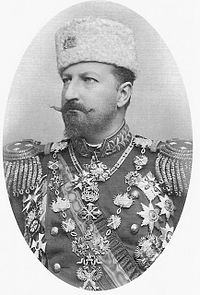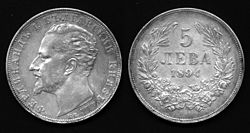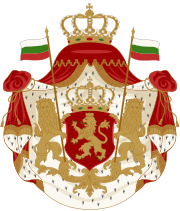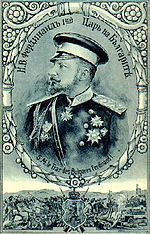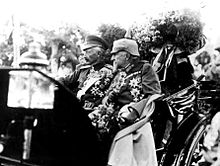· Roman Catholicism to Eastern Orthodox Christianity . However , this move earned him the animosity of his Catholic Austrian relatives , particularly that of his uncle , Emperor Franz Joseph I of Austria
of Bulgaria
5 October 1908 (celebrated on 22 September ), Ferdinand proclaimed Bulgaria 's de jure independence from the Ottoman Empire (though the country had been basically independent since 1878 ). He also elevated Bulgaria to the status of a kingdom , and proclaimed himself tsar or king . The Bulgarian Declaration of Independence was proclaimed by him at the Saint Forty Martyrs Church in Turnovo . It was accepted by Turkey and the other European powers .[ 3 ]
was known for being quite a character . On a visit to German Emperor Wilhelm II , his second cousin once removed , in 1909 , Ferdinand was leaning out of a window of the New Palace in Potsdam when the Emperor came up behind him and slapped him on the bottom . Ferdinand was affronted by the gesture and the Emperor apologised . Ferdinand however exacted his revenge by awarding a valuable arms contract he had intended to give to the Krupp s factory in Essen to French arms manufacturer Schneider -Cruseot .[ 9 ] Another incident particularly occurred on his journey to the funeral of his second cousin , British King Edward VII in 1910 . A tussle broke out on where his private railway carriage would be positioned in relation to the heir to the Austro -Hungarian throne , Archduke Franz Ferdinand . The Archduke won out , having his carriage positioned directly behind the engine . Ferdinand 's was placed directly behind . Realising the dining car of the train was behind his own carriage , Ferdinand obtained his revenge on the Archduke by refusing him entry through his own carriage to the dining car .[ 10 ] On 15 July the same year during a visit to Belgium Ferdinand also became the first head of state to fly in an airplane .[ 11 ]
Wars
article: Balkan Wars many a ruler of an Orthodox land before him , Ferdinand had a "dream of a new Byzantium ".[ 12 ] In 1912 , Ferdinand joined the other Balkan states in an assault on the Ottoman Empire to free occupied territories . He saw this war as a new crusade declaring it , "a just , great and sacred struggle of the Cross against the Crescent ."[ 13 ] Bulgaria contributed the most and also lost the greatest number of soldiers . The great powers insisted on the creation of an independent Albania .[ 3 ] Soon after , Bulgaria attacked its recent allies Serbia and Greece and itself was attacked by Romania and the Ottoman Empire and was defeated . Nevertheless , the Treaty of Bucharest in 1913 gave some territorial gains to Bulgaria . A tiny area of land giving access to the Aegean Sea was secured .[ 3 ]
World War and abdication
Wilhelm and Tsar Ferdinand in Sofia ,
1916
11 October 1915 , the Bulgarian army attacked Serbia after signing a treaty with Austria -Hungary and Germany stating that Bulgaria would gain the territory she sought at the expense of Serbia . See Serbian Campaign (World War I )for details . Ferdinand was not an admirer of German Emperor Wilhelm II (his second cousin once removed ) or Emperor of Austria Franz Josef I whom he described as "that idiot , that old dotard of a Francis Joseph ".[ 14 ] But Ferdinand wanted extra territorial gains after the humiliation of the Balkan Wars . This did however mean forming an alliance with his former enemy , the Ottoman Empire
first the war went well , Serbia was defeated and Bulgaria took possession of most of the disputed territory of Macedonia . For the next two years , the Bulgarian army fought a defensive war against the Allied army based in Greece . Part of the Bulgarian army was involved in the conquest of Romania in 1916 .
in the fall of 1918 , the Bulgarian army was badly beaten by an attack from the Allied forces in Greece . With his army shattered , Tsar Ferdinand abdicated to save the Bulgarian throne in favour of his eldest son who became Tsar Boris III on 3 October 1918 .[ 15 ] Under new leadership , Bulgaria surrendered to the Allies and as a consequence , lost not only the additional territory it had fought for in the major conflict , but also the territory it had won after the Balkan Wars giving access to the Aegean Sea .[ 15 ]
and death
styles of Ferdinand I of The Bulgarians
style Majesty
style Majesty
style
his abdication , Ferdinand returned to live in Coburg Germany . He had managed to salvage much of his fortune and was able to live in some style .[ 16 ] He saw his being in exile simply as one of the hazards of kingship .[ 16 ] He commented , "Kings in exile are more philosophic under reverses than ordinary individuals ; but our philosophy is primarily the result of tradition and breeding , and do not forget that pride is an important item in the making of a monarch . We are disciplined from the day of our birth and taught the avoidance of all outward signs of emotion . The skeleton sits forever with us at the feast . It may mean murder , it may mean abdication , but it serves always to remind us of the unexpected . Therefore we are prepared and nothing comes in the nature of a catastrophe . The main thing in life is to support any condition of bodily or spiritual exile with dignity . If one sups with sorrow , one need not invite the world to see you eat ."[ 17 ] He was pleased that the throne could pass to his son . Ferdinand was not displeased with exile and spent most of his time devoted to artistic endeavors , gardening , travel and natural history . However , he would live to see the collapse of everything he had held to be precious in life .[ 17 ] His eldest son and successor , Boris III , died under mysterious circumstances after returning from a visit to Hitler in Germany in 1943 . Boris III 's son , Simeon II , succeeded him only to be deposed in 1946 , ending the Bulgarian monarchy . The Kingdom of Bulgaria was succeeded by the People 's Republic of Bulgaria , under which his sole surviving son , Kyril was executed . On hearing of his son 's death he said , "Everything is collapsing around me ."[ 18 ] He died a broken man in Bürglaß -Schlösschen on September 10 , 1948 in Coburg Germany , cradle of the Saxe -Coburg -Gotha dynasty . His final wish was to be buried in Bulgaria , and for this reason his coffin lies in the crypt of St . Augustin 's Roman Catholic Church in Coburg .[ 1 ]
of Ferdinand I of Bulgaria
a b Louda , 1981 , Lines of Succession Table 149 a b Finestone , 1981 , The Last Courts of Europe p 227 a b c d Louda , 1981 , Lines of Succession p 297 a b Aronson , 1986 , Crowns In Conflict p 83 Constant , 1986 , Foxy Ferdinand p 96 Constant , 1986 , Foxy Ferdinand p 143 Aronson , 1986 , Crowns In Conflict p 85 Constant , 1986 , Foxy Ferdinand p 266 Aronson , 1986 , Crowns In Conflict pp 8 –9 Aronson , 1986 , Crowns In Conflict p 7 "King up in Aeroplane: Ferdinand of Bulgaria First Monarch to Do It – Sons Fly Also " (Adobe Acrobat ). New York Times website New York Times . 16 July 1910 . p . 1 . http: //query .nytimes .com /mem /archive -free /pdf ?res =9B04E1DC1239E433A25755C1A9619C946196D6CF . Retrieved 2010 -07 -17 . Aronson , 1986 , Crowns In Conflict p 86 Aronson , 1986 , Crowns In Conflict p 87 Aronson , 1986 , Crowns In Conflict p 126 a b Palmer , 1978 , The Kaiser p 206 a b Aronson , 1986 , Crowns In Conflict p 201 a b Aronson , 1986 , Crowns In Conflict p 175 Aronson , 1986 , Crowns In Conflict p 202
links
Theo 1986 ). Crowns In Conflict: The Triumph And The Tragedy Of European Monarchy , 1910 –1918 London: J .Murray . ISBN 0719542790 . Jeffrey (1981 ). The Last Courts of Europe London: J .M .Dent & Sons Ltd . ISBN 0460045199 . Jiri ; Michael Maclagan (1981 ). Lines of Succession London: Orbis Publishing Ltd . ISBN 0460045199 . Stephen (1986 ). Foxy Ferdinand , 1861 –1948 , Tsar of Bulgaria London: Sidgwick and Jackson . ISBN 0238985151 . Alan (1978 ). The Kaiser: Warlord Of The Second Reich London: Weidenfeld and Nicolson . ISBN 0297773933 .
· d · e of Saxe -Coburg and Gotha , dukes in Saxony
generation
generation
generation
generation
generation
generation
generation
I of Bulgaria
names
description
of birth February 1861
of birth Austrian Empire
of death September 1948
of death West Germany
century Bulgarian monarchs century Bulgarian monarchs Marshals of Germany of the Golden Fleece of the Order of Bravery of the Order of St Alexander of the Military Order of Max Joseph family royalty of Saxe -Coburg and Gotha (Bulgaria )births deaths of Saxe -Coburg and Gotha from Vienna people from Bulgaria people of the Balkan Wars people of World War I monarchs Grand Cross of the Order of Saint Stephen of Hungary of the Order of the Most Holy Annunciation Grand Cross of the Military Order of Maria Theresa Knights Grand Cross of the Royal Victorian Order
Foundation 2010
at other dictionaries:
United States relations Bulgarian American relations , first formally established in 1903 , have moved from missionary activity and American support for Bulgarian independence in the late 19th century to the growth of trade and commerce in the early 20th century , to … … Wikipedia
Infobox Country native name = bg . Република България bg . Republika Balgaria This article uses the official Bulgarian transliteration system when romanizing Bulgarian Cyrillic . For details , see Romanization of Bulgarian .] local name = bg . Balgaria … Wikipedia
I of Romania Infobox Romanian Royalty |monarch name =Ferdinand I title =King of the Romanians caption = reign =OldStyleDate |10 October |1914 |27 September 20 July , 1927 coronation = full name =Ferdinand Viktor Albert Meinrad of Hohenzollern predecessor =Carol I … … Wikipedia
Infobox Given Name Revised name = Ferdinand imagesize = caption = pronunciation = gender = meaning = region = origin = Germanic related names = footnotes = Ferdinand is a Germanic given name composed of the words for prepared / protection / safety … … Wikipedia
A European kingdom in the northeastern part of the Balkan Peninsula Catholic Encyclopedia . Kevin Knight . 2006 . Bulgaria Bulgaria † … Catholic encyclopedia
Ier de Bulgarie 1er Tsar de Bulgarie Règne 7 juillet 1887 3 octobr … Wikipédia en Français
I . (Bulgarien )Ferdinand I . von Bulgarien , 1915 Ferdinand I . (* 26 . Februar 1861 in Wien ; † 10 . September 1948 in Coburg ) war Fürst und König (bulg . Zar ) von Bulgarien aus der Dynastie Sachsen Coburg Koháry der Wettiner … Deutsch Wikipedia
I . von Sachsen -Coburg Ferdinand I . von Bulgarien , 1915 Ferdinand I . von Bulgarien , 1928 … Deutsch Wikipedia
I may refer to: * Ferdinand I of León , the Great (ca . 1000 1065 , king from 1037 ) * Ferdinand I of Portugal and the Algarves (1345 1383 , king from 1367 ) * Ferdinand I of Aragon and Sicily , of Antequera (1379 1416 , king from 1412 ) * Ferdinand II of … … Wikipedia
Ferdinand1 [fʉrd ′ n and ] n . [Fr ; prob . < Gmc * farthi , journey < faran , to travel (see FARE ) + * nanths , courage > Goth ( ana )nanthjan , to be bold , OE nethan , to dare ; hence , lit ., ? bold traveler ] a masculine name Ferdinand2 [fʉrd ′ n … … English World dictionary
